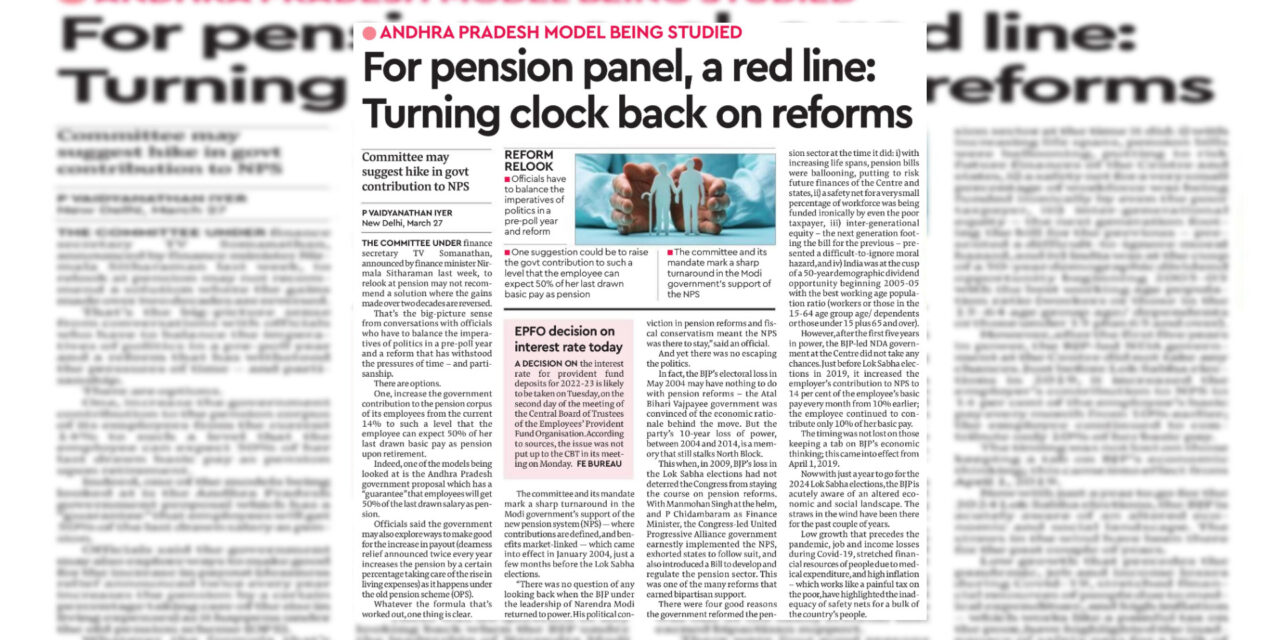ANDHRA PRADESH MODEL BEING STUDIED
For pension panel, a red line: Turning clock back on reforms, Committee may suggest hike in govt contribution to NPS
PVAIDYANATHAN IYER New Delhi, March 27
THE COMMITTEE UNDER finance
secretary TV Somanathan,
announced by finance minister Nirmala Sitharaman last week, to relook at pension may not recommend a solution where the gains made over two decades are reversed. That’s the big-picture sense from conversations with officials who have to balance the impera- tives of politics in a pre-poll year and a reform that has withstood the pressures of time – and parti- sanship.
There are options.
One, increase the government contribution to the pension corpus of its employees from the current 14% to such a level that the employee can expect 50% of her last drawn basic pay as pension. upon retirement.
Indeed, one of the models being looked at is the Andhra Pradesh government proposal which has a “guarantee” that employees will get 50% of the last drawn salary as pen- sion.
Officials said the government may also explore ways to make good for the increase in payout (dearness relief announced twice every year increases the pension by a certain percentage taking care of the rise in living expenses) as it happens under the old pension scheme (OPS).
REFORM RELOOK
Officials have to balance the imperatives of politics in a pre-poll year and reform
One suggestion could be to raise the govt contribution to such a level that the employee can expect 50% of her last drawn basic pay as pension
EPFO decision on interest rate today
A DECISION ON the interest the politics. rate for provident fund deposits for 2022-23 is likely to be taken on Tuesday, on the second day of the meeting of the Central Board of Trustees of the Employees’ Provident Fund Organisation.According to sources, the issue was not put up to the CBT in its meet- ing on Monday. FE BUREAU
The committee and its mandate mark a sharp turnaround in the Modi government’s support of the new pension system (NPS)-where contributions are defined, and ben- efits market-linked – which came into effect in January 2004, just a few months before the Lok Sabha elections.
However, after the first five years in power, the BJP-led NDA govern- ment at the Centre did not take any chances. Just before Lok Sabha elec- tions in 2019, it increased the employer’s contribution to NPS to 14 per cent of the employee’s basic pay every month from 10% earlier; the employee continued to con-
Whatever the formula that’s worked out, one thing is clear.
sion sector at the time it did: i) with increasing life spans, pension bills were ballooning, putting to risk future finances of the Centre and states, ii) a safety net for a very small percentage of workforce was being funded ironically by even the poor taxpayer, iii) inter-generational equity-the next generation foot- ing the bill for the previous – pre- The committee and its sented a difficult-to-ignore moral hazard, and iv) India was at the cusp of a 50-year demographic dividend opportunity beginning 2005-05 with the best working age popula- tion ratio (workers or those in the 15-64 age group age/ dependents or those under 15 plus 65 and over).
mandate mark a sharp turnaround in the Modi government’s support of the NPS
viction in pension reforms and fis- cal conservatism meant the NPS was there to stay,” said an official. And yet there was no escaping
In fact, the BJP’s electoral loss in May 2004 may have nothing to do with pension reforms – the Atal Bihari Vajpayee government was convinced of the economic ratio- nale behind the move. But the tribute only 10% of her basic pay. party’s 10-year loss of power, between 2004 and 2014, is a mem- ory that still stalks North Block.
The timing was not lost on those keeping a tab on BJP’s economic thinking; this came into effect from April 1, 2019.
Now with just a year to go for the 2024 Lok Sabha elections, the BJP is acutely aware of an altered eco- nomic and social landscape. The straws in the wind have been there
This when, in 2009, BJP’s loss in the Lok Sabha elections had not deterred the Congress from staying the course on pension reforms. With Manmohan Singh at the helm, and P Chidambaram as Finance Minister, the Congress-led United for the past couple of years. Progressive Alliance government earnestly implemented the NPS, exhorted states to follow suit, and also introduced a Bill to develop and regulate the pension sector. This was one of the many reforms that earned bipartisan support.
Low growth that precedes the pandemic, job and income losses during Covid-19, stretched finan- cial resources of people due to med- ical expenditure, and high inflation which works like a painful tax on the poor, have highlighted the inad- There were four good reasons equacy of safety nets for a bulk of
“There was no question of any looking back when the BJP under the leadership of Narendra Modi returned to power. His political con- the government reformed the pen- the country’s people.





